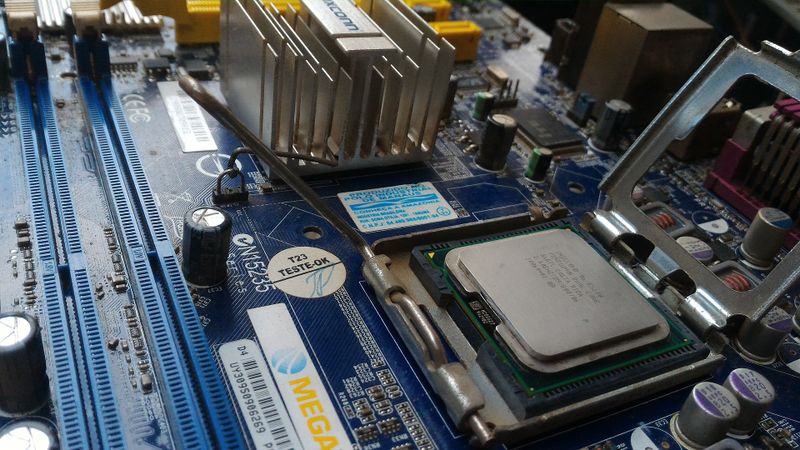Intels 10th-gen Series CPUs Revealed: Up To 10 Cores and 5.3 GHz on 14nm++++
Intel's 10th generation "Comet Lake" CPUs will have hyperthreading across the board. Clock speeds are 100-200 MHz higher and so are TDPs for the K-series chips. The platform will use a new socket LGA 1200 and have 2.5 Gigabit Ethernet as a standard feature. The new i9-10900K flagship will be capable of running at up to 5.3 GHz given adequate cooling.
written by 林慧 (Wai Lin) 2020-01-01 - last edited 2020-01-04. © CC BY

The Spanish technology website Informaticacero has published several slides outlining Intel's 10 generation CPU line-up. The slides match the specifications for the 10th generation i3-10100 which we reported back in October 2019 and they appear to be genuine.
The leaked slides reveal that Intel's "next generation" CPUs will be made on the same 14nm (+++) process node the last few previous generations were made on.
The entire 10th generation line-up will have hyperthreading (SMT). This is a feature Intel has long used to segment their products. That is no longer the case.
The leaked slides list a new "Velocity" clock speed which is used instead of the familiar "boost" clocks if the temperature is below a certain - currently unknown - threshold. This seems similar to the way second and third generation AMD Ryzen chips boost higher when there is adequate cooling.
Core i9 and i7 flagships[edit]
| Model | Cores | Threads | Base clock (GHz) | All-Core Boost (GHz) | Single Core Boost (GHz) | Single Core Turbo 3.0 (GHz) | All/Single Core Velocity (GHz) | Single Core Velocity (GHz) | TDP (Watts) |
|---|---|---|---|---|---|---|---|---|---|
| i9-10900K | 10 | 20 | 3.7 | 4.8 | 5.1 | 5.2 | 4.9 | 5.3 | 125W |
| i9-10900 | 10 | 20 | 2.8 | 4.5 | 5.0 | 5.1 | 4.6 | 5.1 | 65W |
| i7-10700K | 8 | 16 | 3.8 | 4.7 | 5.0 | 5.1 | - | - | 125W |
| i7-10700 | 8 | 16 | 2.9 | 4.6 | 4.7 | 4.8 | - | - | 65W |
Intel lists 125W as the TDP for their highest-clocked i9 and i7 CPUs. This could either mean that they are listing a more realistic TDP than they did with previous lineups or it could mean that the new flagchips will require a serious water cooling solutions.
It is interesting to note that the i7-10700K appears to have the exact same specification as the previous generation's i9-9900K.
The mid-range i5s[edit]
There are no special "Velocity" clocks on the i5 line-up. That feature appears to be reserved for the higher-end chips. The new i5s do have hyperthreading and 200 MHz higher boost clocks. If that is enough to challenge AMDs very competitive offerings will largely depend on pricing.
| Model | Cores | Threads | Base clock (GHz) | All-Core Boost (GHz) | Single Core Boost (GHz) | Single Core Turbo 3.0 (GHz) | TDP (Watts) |
|---|---|---|---|---|---|---|---|
| i5-10600K | 6 | 12 | 4.1 | 4.5 | 4.8 | 125W | |
| i5-10600 | 6 | 12 | 3.3 | 4.4 | 4.8 | 65W | |
| i5-10500 | 6 | 12 | 3.1 | 4.2 | 4.5 | 65W | |
| i5-10400 | 6 | 12 | 2.9 | 4.0 | 4.3 | 65W |
The low-end[edit]
| Model | Cores | Threads) | Base clock (GHz) | All-Core Boost (GHz) | Single Core Boost (GHz) | Single Core Turbo 3.0 (GHz) | TDP (Watts) |
|---|---|---|---|---|---|---|---|
| i3-10320 | 4 | 8 | 3.8 | 4.4 | 4.6 | 65W | |
| i3-10300 | 4 | 8 | 3.7 | 4.2 | 4.4 | 65W | |
| i3-10100 | 4 | 8 | 3.6 | 4.1 | 4.3 | 65W |
There is not too much to be excited about in Intel's budget line-up apart from hyperthreading. Clocks are 200 MHz higher for the i3-10320 and 100 MHz higher for the remaining chips. Yet, it is in some sense impressive from a historical perspective. The seventh generation i7-7700K flagship was a 4 core 8 thread part with the almost exact same specifications as the i3-10320.
The Platform[edit]
Intel will use a new socket called LGA 1200 for their tenth generation chips. Existing motherboards will not be usable.
The new platform will support DDR4 RAM up to 2933 MHz, Wi-Fi 6 (802.11ax) and 2.5 Gigabit Ethernet. Faster cabled networking on consumer products is a very welcome upgrade. Gigabit Ethernet over cat 5 and 6 UTP cabling (1000BASE-T) was standardized in 1999. There has been notable progress in most other areas the last 20 years so it is nice to see that common Ethernet speeds are finally progressing.
It is somewhat disappointing, but not unexpected, that Intel is releasing yet another "new" generation CPUs on their aging 14nm (with a never-ending series of ++++) node. Intel spent billions increasing their 14nm capacity last year due to the CPU supply shortages they have been struggling with while their 10nm capacity remains limited in both quality and quantity.
The "Comet Lake" Cpus have the same utterly Intel's very broken conditional jump code handling previous generation Intel chips have. The errata notification and firmware fixes came late November. The 10th generation chips were taped out at that point.
The leaked slides do not indicate any release-date. As for the purpose of the slides: CES 2020 starts January 7th. Intel will likely use that event to promote their new line-up which means that the chips may hit store shelves around February/March.


Enable comment auto-refresher